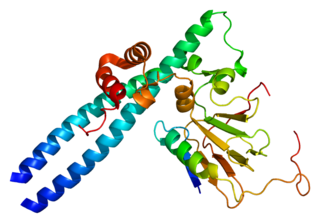Transcription factor E2F2 is a protein that in humans is encoded by the E2F2 gene. [5] [6]
Transcription factor E2F2 is a protein that in humans is encoded by the E2F2 gene. [5] [6]
The protein encoded by this gene is a member of the E2F family of transcription factors. The E2F family plays a crucial role in the control of cell cycle and action of tumor suppressor proteins and is also a target of the transforming proteins of small DNA tumor viruses. The E2F proteins contain several evolutionally conserved domains found in most members of the family. These domains include a DNA binding domain, a dimerization domain which determines interaction with the differentiation regulated transcription factor proteins (DP), a transactivation domain enriched in acidic amino acids, and a tumor suppressor protein association domain which is embedded within the transactivation domain. This protein and another 2 members, E2F1 and E2F3, have an additional cyclin binding domain. This protein binds specifically to retinoblastoma protein pRB in a cell-cycle dependent manner, and it exhibits overall 46% amino acid identity to E2F1. [7]
E2F2 has been shown to interact with:
E2F is a group of genes that encodes a family of transcription factors (TF) in higher eukaryotes. Three of them are activators: E2F1, 2 and E2F3a. Six others act as suppressors: E2F3b, E2F4-8. All of them are involved in the cell cycle regulation and synthesis of DNA in mammalian cells. E2Fs as TFs bind to the TTTCCCGC consensus binding site in the target promoter sequence.

Histone acetyltransferase p300 also known as p300 HAT or E1A-associated protein p300 also known as EP300 or p300 is an enzyme that, in humans, is encoded by the EP300 gene. It functions as histone acetyltransferase that regulates transcription of genes via chromatin remodeling by allowing histone proteins to wrap DNA less tightly. This enzyme plays an essential role in regulating cell growth and division, prompting cells to mature and assume specialized functions (differentiate), and preventing the growth of cancerous tumors. The p300 protein appears to be critical for normal development before and after birth.

Cyclin-dependent kinase 4 also known as cell division protein kinase 4 is an enzyme that in humans is encoded by the CDK4 gene. CDK4 is a member of the cyclin-dependent kinase family.

Transcription factor E2F1 is a protein that in humans is encoded by the E2F1 gene.

Retinoblastoma-like protein 2 is a protein that in humans is encoded by the RBL2 gene.

M-phase inducer phosphatase 1 also known as dual specificity phosphatase Cdc25A is a protein that in humans is encoded by the cell division cycle 25 homolog A (CDC25A) gene.

Transcription factor E2F4 is a protein that in humans is encoded by the E2F4 gene.

G1/S-specific cyclin-E1 is a protein that in humans is encoded by the CCNE1 gene.

Cell division control protein 6 homolog is a protein that in humans is encoded by the CDC6 gene.

Cyclin-A1 is a protein that in humans is encoded by the CCNA1 gene.

Transcription factor E2F3 is a protein that in humans is encoded by the E2F3 gene.

Histone-binding protein RBBP7 is a protein that in humans is encoded by the RBBP7 gene.

Transformation/transcription domain-associated protein, also known as TRRAP, is a protein that in humans is encoded by the TRRAP gene. TRRAP belongs to the phosphatidylinositol 3-kinase-related kinase protein family.

Retinoblastoma-like 1 (p107), also known as RBL1, is a protein that in humans is encoded by the RBL1 gene.

Transcription factor Dp-1 is a protein that in humans is encoded by the TFDP1 gene.

Nuclear receptor coactivator 6 is a protein that in humans is encoded by the NCOA6 gene.

Transcription factor E2F5 is a protein that in humans is encoded by the E2F5 gene.

Transcription factor Dp-2 is a protein that in humans is encoded by the TFDP2 gene that dimerises with E2F, a key transcriptional activator involved in the regulation of the cell cycle.

General transcription factor IIF subunit 1 is a protein that in humans is encoded by the GTF2F1 gene.

The retinoblastoma protein is a tumor suppressor protein that is dysfunctional in several major cancers. One function of pRb is to prevent excessive cell growth by inhibiting cell cycle progression until a cell is ready to divide. When the cell is ready to divide, pRb is phosphorylated, inactivating it, and the cell cycle is allowed to progress. It is also a recruiter of several chromatin remodeling enzymes such as methylases and acetylases.
This article incorporates text from the United States National Library of Medicine, which is in the public domain.